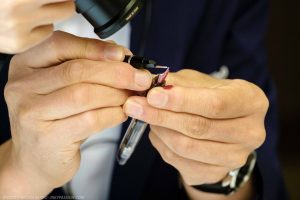Pen doctor Atsushi Takizawa from Pilot Corporation Japan is in Singapore for the Pilot pen clinic from 27th – 29th July. In this Inky Passion exclusive interview, Mr Takizawa shares some experiences from his line of work and the challenges that he faces when tuning nibs.
Mr Atsushi Takizawa joined PILOT Corporation (formally called The PILOT PEN CO. LTD) in 1981. After 14 years of career in mould designing for fountain pens and jewellery, he joined the tip manufacturing section and has acquired vast knowledge and its technique. Since 2005, he has been travelling extensively globally to service Namiki pens.
Why are Japanese nibs regarded as smoother and more consistent compared to Western ones?
Maybe it came from the characteristics of Japanese Kanji letters. In English, there are block letters and italic letters, but Japanese letters are very individual and have to be written accurately – you need a nib that is stable (hard), fine and good at every angle.
What is the secret to making a good nib?
The feeder is very important when making a good nib. It depends on whether the feeder is good or not. This is the heart of the fountain pen, but all the other parts are also important. The feeder must provide stable ink flow to the nib so when you design, you need to keep this in mind. Our specialty is that all parts are made by us, whereas other makers combine different pen parts when manufacturing a pen. We are one of the few companies that manufacture everything in our own factory.
What are some of the common problems that fountain pen users face, and do you suggest customising standard fountain pen nibs?

The issues are quite common whether in Singapore or Japan. Usually the ink does not come out correctly – it doesn’t flow well or the nib is scratchy. For some customers who have different pen holding habits I will do some customisation, but otherwise I would not recommend it. There are some people who modify the tip of the nib themselves, and they are never successful, so you should not attempt it.
Is there a reason why Namiki does not offer as wide a range of nibs as Pilot, say the FA, SF, SU nib?
Frankly, this is an issue only in countries like Singapore – in Japan and most other countries we don’t get such requests because they don’t have a culture of using Namiki pens daily. There, Namiki pens are seen as collectibles and put on display, so requests for specialty nibs aren’t common in Japan as compared with here in Singapore.
Why has Pilot replaced the CON-20 and CON-50 with the CON-40?
We discontinued the converters because due to procurement problems, it is difficult to get production material. We cannot keep the quality and production cost so we need to make a new one.

Why is it that over the years, more and more people have started to enjoy using fountain pens?

Unlike other pens like a ballpoint pen, a fountain pen can reflect the user’s personality. You get a special touch, and writing is different – so you can convey what is in your heart to the person you are writing to. Also, because the point is always touching the paper, it will become much smoother the more you use it.
How should Maki-e pens be stored – is it better to keep them in the box or used?
Maki-e pens should be kept in a humid environment and not exposed to UV rays – exposing them to harmful conditions may cause them to turn white (bleaching). If you want to keep a pen as new as possible, then keep it in the box with a little moisture but not too dry.
It depends on your personal preference – some people say that if you use an urushi product often, the oil on your hands will make it more lustrous, and this has a kind of value. If you intend to sell it later, you had better not use it.
Other facts about Mr Takizawa:
Mr Takizawa is primarily a fountain pen user, not a collector. His favourite pen is a vintage Pilot Capless FCN500R in black from 1984, the year he joined the company. He also enjoys using Pelikan’s M400 and M600 size Souverän fountain pens (he says the M100 and M1000 are too extreme) and sometimes makes slight adjustments to them to suit his writing style. In his free time, Mr Takizawa enjoys cycling.
Members of the public interested to attend the event should visit the www.pilotpen.com.sg/penclinic2016 microsite or call a local retailer for more information.
This interview was translated into English from the Japanese language. In spite of linguistic differences, all efforts have been made to ensure accuracy.
Photos: Nicholas Yeo / Inky Passion





